An Overview of Heel Spurs
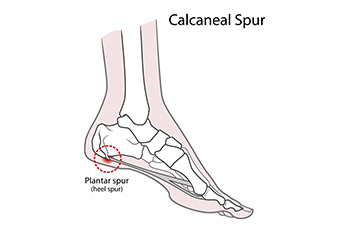
A heel spur is a common foot condition that is often discussed in the context of heel pain and discomfort. Despite their reputation, they are not actually sharp, pointy growths, as the term may imply. Instead, heel spurs are calcium deposits that form on the underside of the heel bone. These deposits often develop over an extended period of time due to chronic inflammation or stress on the plantar fascia, the band of tissue that connects the heel to the toes. The primary characteristic of heel spurs is the accompanying pain. This discomfort is often described as a sharp, stabbing sensation, particularly with the first steps in the morning or after prolonged periods of rest. It is important to note that not everyone with heel spurs experiences pain, as many people have them without any symptoms. The causes of heel spurs are diverse, with factors such as obesity, gait abnormalities, or wearing inadequate footwear contributing significantly. Heel spurs are a condition that is often linked to heel pain, but they are generally not the sole cause. If you are experiencing persistent heel pain, it is suggested that you consult a podiatrist, who can accurately diagnose and treat heel spurs if they are the culprit.
Heel spurs can be incredibly painful and sometimes may make you unable to participate in physical activities. To get medical care for your heel spurs, contact Dr. Steven Shlonsky from Louisville, Kentucky. Dr. Shlonsky will do everything possible to treat your condition.
Heels Spurs
Heel spurs are formed by calcium deposits on the back of the foot where the heel is. This can also be caused by small fragments of bone breaking off one section of the foot, attaching onto the back of the foot. Heel spurs can also be bone growth on the back of the foot and may grow in the direction of the arch of the foot.
Older individuals usually suffer from heel spurs and pain sometimes intensifies with age. One of the main condition's spurs are related to is plantar fasciitis.
Pain
The pain associated with spurs is often because of weight placed on the feet. When someone is walking, their entire weight is concentrated on the feet. Bone spurs then have the tendency to affect other bones and tissues around the foot. As the pain continues, the feet will become tender and sensitive over time.
Treatments
There are many ways to treat heel spurs. If one is suffering from heel spurs in conjunction with pain, there are several methods for healing. Medication, surgery, and herbal care are some options.
If you have any questions feel free to contact our office located in Louisville, KY . We offer the latest in diagnostic and treatment technology to meet your needs.
Common Ways to Break an Ankle
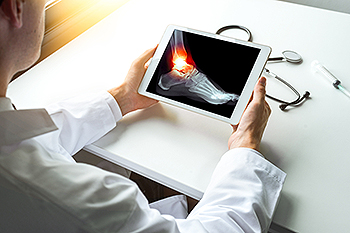
A broken ankle occurs when one of more of the three bones that make up the ankle joint is injured. This includes the tibia and fibula, which are calf bones and the talus, which is a web-shaped bone inside the joint. Following are common causes of a broken ankle. Car accidents can often be the source of crushing injuries that can result in an ankle fracture. Also, if you jump from a height and land on your feet, it can result in ankle bone injuries. When a heavy weight falls on your foot, it can break your ankle. Sometimes, when you miss a step while climbing up the stairs or walking down, you can break your ankle. The weight-bearing bones in your feet and ankles are prone to stress. Strong, repetitive forces or overuse, like running for long distances, can result in tiny cracks in them. Stress fractures and bone thinning conditions, such as osteoporosis, can also result in ankle bone injuries. Falling on slippery and wet surfaces, tripping, or stepping into a hole can cause ankle fractures and injuries. When you place the foot down in a wrong manner, twist the ankle, or apply excess pressure on your foot, you can break your ankle. If you believe that you have broken a bone in your ankle, it is strongly suggested that you seek immediate medical attention from a podiatrist.
Broken ankles need immediate treatment. If you are seeking treatment, contact Dr. Steven Shlonsky from Louisville, Kentucky. Dr. Shlonsky can provide the care you need to keep you pain-free and on your feet.
Broken Ankles
A broken ankle is experienced when a person fractures their tibia or fibula in the lower leg and ankle area. Both of these bones are attached at the bottom of the leg and combine to form what we know to be our ankle.
When a physician is referring to a break of the ankle, he or she is usually referring to a break in the area where the tibia and fibula are joined to create our ankle joint. Ankles are more prone to fractures because the ankle is an area that suffers a lot of pressure and stress. There are some obvious signs when a person experiences a fractured ankle, and the following symptoms may be present.
Symptoms of a Fractured Ankle
- Excessive pain when the area is touched or when any pressure is placed on the ankle
- Swelling around the area
- Bruising of the area
- Area appears to be deformed
If you suspect an ankle fracture, it is recommended to seek treatment as soon as possible. The sooner you have your podiatrist diagnose the fracture, the quicker you’ll be on the way towards recovery.
If you have any questions, please feel free to contact our office located in Louisville, KY . We offer the newest diagnostic and treatment technologies for all your foot care needs.
Causes and Effective Treatments for Foot Blisters
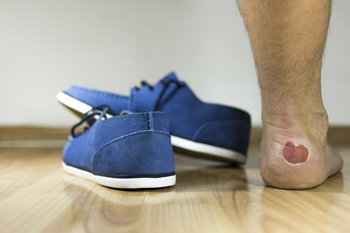
Foot blisters are a common issue, particularly among athletes and active individuals. These fluid-filled sacs typically form due to friction and pressure, often caused by ill-fitting shoes or repetitive movements. Moisture and heat can exacerbate the problem, making the feet more susceptible to blisters. When it comes to treatment, the first step is to keep the area clean to prevent infection. Refrain from popping the blister, as the fluid acts as a natural barrier that promotes healing. Cover the blister with a sterile bandage or moleskin to reduce friction. If the blister does burst, clean it gently with soap and water, apply an antibiotic ointment, and cover it. Wearing well-fitting, moisture-wicking socks and properly-sized shoes can help prevent future blisters. Using blister pads or bandages on areas prone to friction can also reduce the risk. Ultimately, taking steps to minimize friction and maintaining good foot hygiene can go a long way in preventing and treating foot blisters effectively. If you have discomfort from foot blisters, it is suggested that you make an appointment with a podiatrist for care.
Blisters are prone to making everyday activities extremely uncomfortable. If your feet are hurting, contact Dr. Steven Shlonsky of Louisville, Kentucky. Dr. Shlonsky can provide the care you need to keep you pain-free and on your feet.
Foot Blisters
Foot blisters develop as a result of constantly wearing tight or ill-fitting footwear. This happens due to the constant rubbing from the shoe, which can often lead to pain.
What Are Foot Blisters?
A foot blister is a small fluid-filled pocket that forms on the upper-most layer of the skin. Blisters are filled with clear fluid and can lead to blood drainage or pus if the area becomes infected.
How Do Blisters Form?
Blisters on the feet are often the result of constant friction of skin and material, usually by shoe rubbing. Walking in sandals, boots, or shoes that don’t fit properly for long periods of time can result in a blister. Having consistent foot moisture and humidity can easily lead to blister formation.
Prevention & Treatment
It is important to properly care for the affected area in order to prevent infection and ease the pain. Do not lance the blister and use a Band-Aid to provide pain relief. Also, be sure to keep your feet dry and wear proper fitting shoes. If you see blood or pus in a blister, seek assistance from a podiatrist.
If you have any questions, please feel free to contact our office located in Louisville, KY . We offer the newest diagnostic and treatment technologies for all your foot care needs.
Diagnosis and Treatment of Cuboid Syndrome in Athletes
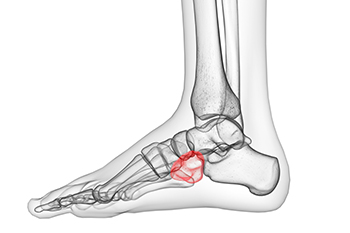
Cuboid syndrome is a relatively uncommon but painful condition that can affect athletes, particularly those engaged in sports that involve repetitive foot movements or sudden directional changes. It occurs when the cuboid bone in the foot becomes misaligned or irritated, leading to discomfort and limited mobility. Diagnosing cuboid syndrome can be challenging. The symptoms associated with this condition consist of pain along the outer edge of the foot, difficulty bearing weight, and a decreased range of motion and can resemble other foot and ankle injuries. A thorough physical examination, along with imaging studies such as X-rays or an MRI, may be required to confirm the diagnosis. Treatment for cuboid syndrome typically involves conservative approaches. Rest, compression, and elevation can help reduce pain and inflammation. Physical therapy exercises to strengthen foot muscles and improve joint stability are also beneficial. In some cases, manual manipulation by a podiatrist may be necessary to realign the cuboid bone. Athletes experiencing persistent foot pain should seek prompt evaluation and diagnosis, as early intervention can lead to quicker recovery. If you have lateral foot pain, it is suggested that you consult a podiatrist who can accurately diagnose and treat cuboid syndrome.
Cuboid syndrome, also known as cuboid subluxation, occurs when the joints and ligaments near the cuboid bone in the foot become torn. If you have cuboid syndrome, consult with Dr. Steven Shlonsky from Louisville, Kentucky. Dr. Shlonsky will assess your condition and provide you with quality foot and ankle treatment.
Cuboid syndrome is a common cause of lateral foot pain, which is pain on the outside of the foot. The condition may happen suddenly due to an ankle sprain, or it may develop slowly overtime from repetitive tension through the bone and surrounding structures.
Causes
The most common causes of cuboid syndrome include:
- Injury – The most common cause of this ailment is an ankle sprain.
- Repetitive Strain – Tension placed through the peroneus longus muscle from repetitive activities such as jumping and running may cause excessive traction on the bone causing it to sublux.
- Altered Foot Biomechanics – Most people suffering from cuboid subluxation have flat feet.
Symptoms
A common symptom of cuboid syndrome is pain along the outside of the foot which can be felt in the ankle and toes. This pain may create walking difficulties and may cause those with the condition to walk with a limp.
Diagnosis
Diagnosis of cuboid syndrome is often difficult, and it is often misdiagnosed. X-rays, MRIs and CT scans often fail to properly show the cuboid subluxation. Although there isn’t a specific test used to diagnose cuboid syndrome, your podiatrist will usually check if pain is felt while pressing firmly on the cuboid bone of your foot.
Treatment
Just as the range of causes varies widely, so do treatments. Some more common treatments are ice therapy, rest, exercise, taping, and orthotics.
If you have any questions, please feel free to contact our office located in Louisville, KY . We offer the newest diagnostic and treatment technologies for all your foot care needs.
Orthotics Provide Support and Comfort for Your Feet
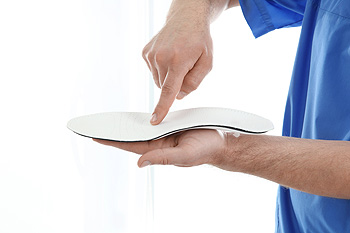
Orthotics refer to custom or prefabricated devices inserted into your shoes to provide support and alleviate various foot and lower limb issues. These inserts are designed to correct abnormal foot function, improve balance, and reduce pain associated with conditions such as flat feet, plantar fasciitis, and bunions. There are several compelling reasons to wear orthotics. They can help redistribute pressure and provide cushioning, which can alleviate discomfort and pain. Orthotics also aid in correcting gait abnormalities, potentially reducing the risk of injuries. For athletes or those on their feet for extended periods, orthotics can enhance performance and endurance. Additionally, they can contribute to overall body alignment, which can alleviate pain in the knees, hips, and lower back.. Wearing orthotics can significantly improve your quality of life by promoting comfort, stability, and better foot health. If you are interested in learning more about orthotics, it is suggested that you contact a podiatrist who can determine which type is right for you.
If you are having discomfort in your feet and would like to try orthotics, contact Dr. Steven Shlonsky from Louisville, Kentucky. Dr. Shlonsky can provide the care you need to keep you pain-free and on your feet.
What Are Orthotics?
Orthotics are inserts you can place into your shoes to help with a variety of foot problems such as flat feet or foot pain. Orthotics provide relief and comfort for minor foot and heel pain but can’t correct serious biomechanical problems in your feet.
Over-the-Counter Inserts
Orthotics come in a wide variety of over-the-counter inserts that are used to treat foot pain, heel pain, and minor problems. For example, arch supports can be inserted into your shoes to help correct overarched or flat feet, while gel insoles are often used because they provide comfort and relief from foot and heel pain by alleviating pressure.
Prescription Orthotics
If over-the-counter inserts don’t work for you or if you have a more severe foot concern, it is possible to have your podiatrist prescribe custom orthotics. These high-quality inserts are designed to treat problems such as abnormal motion, plantar fasciitis, and severe forms of heel pain. They can even be used to help patients suffering from diabetes by treating foot ulcers and painful calluses and are usually molded to your feet individually, which allows them to provide full support and comfort.
If you are experiencing minor to severe foot or heel pain, it’s recommended to speak with your podiatrist about the possibilities of using orthotics. A podiatrist can determine which type of orthotic is right for you and allow you to take the first steps towards being pain-free.
If you have any questions please contact our office located in Louisville, KY . We offer the newest diagnostic and treatment technologies for all your foot and ankle needs.








